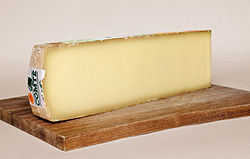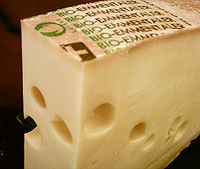 | |
| Country of origin | France |
|---|---|
| Region, town | Franche-Comté |
| Source of milk | Cows |
| Pasteurised | No |
| Texture | semi-hard |
| Aging time | 8-12 months |
| Certification | French AOC 1958 |
Eating Fondue: Yesterday we had fondue for lunch. Here are the cheeses used and the liqueur that is usually in fondue that WAS NOT used. Thank you Wikipedia and the cheese site online for information.
Comté (also called Gruyère de Comté) (French pronunciation: [kɔ̃.te]) is a French cheese made from unpasteurized cow's milk in the Franche-Comté region of eastern France. Comté has the highest production of all French AOC cheeses, around 40,000 tonnes annually.
The cheese is made in flat circular discs, each between 40 cm (16 in) and 70 cm (28 in) in diameter, and around 10 cm (4 in) in height. Each disc weighs up to 50 kg (110 lb) with an FDM around 45%. The rind is usually a dusty-brown colour, and the internal pâte is a pale creamy yellow. The texture is relatively hard and flexible, and the taste is strong and slightly sweet.
| Gruyère | |
|---|---|
 | |
| Country of origin | Switzerland |
| Region, town | Canton of Fribourg, Gruyères |
| Source of milk | Cows |
| Pasteurised | No |
| Texture | hard |
| Aging time | 5-12 months (typical) |
| Certification | Swiss AOC 2001 |
Gruyère (/ɡruːˈjɛər/ or /ɡrɨˈjɛər/; French pronunciation: [ɡʁyjɛʁ]) is a hard yellow cheese, named after the town of Gruyères in Switzerland, and originated in the cantons of Fribourg, Vaud, Neuchâtel,Jura, and Berne. Before 2001, when Gruyère gained Appellation d'Origine Contrôlée (AOC) status as a Swiss cheese, some controversy existed whether French cheeses of a similar nature could also be labeled Gruyère (French Gruyère style cheeses include Comté and Beaufort).
Gruyère is sweet but slightly salty, with a flavor that varies widely with age. It is often described as creamy and nutty when young, becoming with age more assertive, earthy and complex. When fully aged (five months to a year) it tends to have small cracks which impart a slightly grainy texture.[citation needed]
 Emmentaler or Emmental is a yellow, medium-hard cheese that originated in the area aroundEmmental, in Switzerland. It is one of the cheeses of Switzerland, and is sometimes known as Swiss cheese. While the denomination "Emmentaler Switzerland" is protected, "Emmentaler" is not; as such, Emmentaler of other origin, especially from France and Bavaria, is widely available and even Finlandis an exporter of Emmentaler cheese.
Emmentaler or Emmental is a yellow, medium-hard cheese that originated in the area aroundEmmental, in Switzerland. It is one of the cheeses of Switzerland, and is sometimes known as Swiss cheese. While the denomination "Emmentaler Switzerland" is protected, "Emmentaler" is not; as such, Emmentaler of other origin, especially from France and Bavaria, is widely available and even Finlandis an exporter of Emmentaler cheese.
Emmentaler has a savoury, but not very sharp taste. Three types of bacteria are used in the production of Emmentaler: Streptococcus
| Emmentaler | |
|---|---|
| Country of origin | Switzerland |
| Region, town | Berne, Emmental |
| Source of milk | Cows |
| Pasteurised | Traditionally, no |
| Texture | hard |
| Aging time | 2-18 months depending on variety |
| Certification | Some varieties |
thermophilus, Lactobacillus, and Propionibacterium freudenreichii. In the late stage of cheese production, P. freudenreichii consumes the lactic acidexcreted by the other bacteria, and releases carbon dioxide gas, which slowly forms the bubbles that make holes. Failure to remove CO2 bubbles during production, due to inconsistent pressing, results in the large holes ("eyes") characteristic of this cheese. Historically, the holes were a sign of imperfection, and until modern times, cheese makers would try to avoid them.[1] Emmentaler cheese is used in a variety of dishes, including some types of pizza, and ravioli, where it is often accompanied with Prosciutto.

A kirschwasser (/ˈkɪərʃvɑːsər/ keersh-vahs-ər; German: [ˈkɪɐ̯ʃvasɐ], German for “cherry water”) or kirsch is a clear, colorless fruit brandy traditionally made from double distillation of morello cherries, a dark-coloredcultivar of the sour cherry. However, it is now also made from other kinds of cherries. The cherries are fermented complete (that is, including their stones).[1] Unlike cherry liqueurs and so-called “cherry brandies”, kirschwasser is not sweet.
The best kirschwassers have a refined taste with subtle flavors of cherry and a slight bitter-almond taste that derives from the stones.
Our last day with our friends Mary and Doug we went to the Jardin de Luxembourg and past Cluny and the Sorbonne. We went to the Professor's old neighborhood where he served as an LDS mssionary about 45 years ago and eventually settled on the restaurant Assiette aux Fomages for lunch. We had a very good lunch with great cheese fondue and a salad.
One of the proprietors was adamant that it would not be cheese fondue if we did not put in the kirsch. I insisted that they use only white wine. And spoiled the entire meal. Oh it was so good. The got thicker and thicker as the pot emptied. We used chunks of baguette for dipping.
Our last day with our friends Mary and Doug we went to the Jardin de Luxembourg and past Cluny and the Sorbonne. We went to the Professor's old neighborhood where he served as an LDS mssionary about 45 years ago and eventually settled on the restaurant Assiette aux Fomages for lunch. We had a very good lunch with great cheese fondue and a salad.
One of the proprietors was adamant that it would not be cheese fondue if we did not put in the kirsch. I insisted that they use only white wine. And spoiled the entire meal. Oh it was so good. The got thicker and thicker as the pot emptied. We used chunks of baguette for dipping.



No comments:
Post a Comment